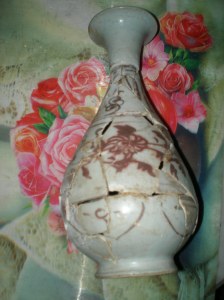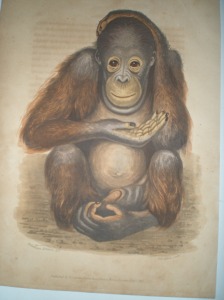INTRODUCTION
The complex innovation of Chinese potters are unique accomplisments int the cultural heritage of mankind*1)
Chinese ceramics are universally the art object most sought by collectors *2)
European were struck with “China mania”*3).
The purpose of this book- based as it is on comprehensive fragment and restored collections of the unique Yuan-Ming red and white colors decorations ceramics.
The type and themes of that rare ceramics most intersesting for collector s and investors because they have always made mistake value estimation*4) and the plaque of reproductions that has recently flooded the international market *5)
The problems above, were one of the porpuse to write this books , if the collectors knows the authentics one , the copies can-not grown.
No English-language study of Chinese ceramic found in Indonesia , especially the unique and rare Yuan and Ming ceramc can found in Indonesia brought by Mongols army during Mongol-Java*6) affairs and Ming ceramic brought by Cenghe,*7)
Copies of underglaze-blue and underglaze-red wares of the “Yuan “ dynasty provoked international lawsuits.*8)
Near the end of the 15th century , probably as a respond to the popularity and high price of Chinese blue-and-white porcelein , the Ottoman court in Istanbul decided to sponsor the production of high-quality ceramic *9)
*1) He Li(2007) page 9
From the eight- ninth centuries onward , innumeralbe Chinese ceramic wares were transport along the silk road route, reaching as far west as Egypt and Africa.(From the country in that area only some wares send to Indonesia and other South East Asia country-auth)
*2) ibid *1 page 9
Practical, decorative ceramic wares , howeever his or hers culture and social status. Perhaps this is why Chinese ceramic are universally the art objects most sought after by museums and individual collectors having intersest in the art of Asia.
*3)ibid *1 page 11
Interest in underglaze blue ware in Europe was accelerated by export wares shipped from china to South east Asia ( including Indonesia as the tranfereed ports like Tuban ,Cheribon and Banten –auth)
Later, the connoisseurship of object with brilliant polychrome decoration benefied from the export of porcelein by sea from southen China , primarily managed by the Dutch Eas Indie company (VOC-auth), frm the seventeenth century.
A lack of investigation into how costume changed in the course of time has resulted in anchronistic interpretations for figural object.
*4) ibid *1 page 9-10
The lack study of peripheral kiln has ,so far , impeded Westren (Including Indonesia-auth) of this important industries . For example the type of white –glazed porcelein from Dehua in Fujian province (I just travel there, my grandpa homeland Tjiangtjieo(Changqou)-auth)., comonly known in the west as “Blanc de chine” and generally thought to date from the seventeenth century, as, in fact, first produce in tenth century. In he historical introductiion to each chapter , new discoveries by regional ceramics expert are reported.
*5) ibid *1 page 10
Among countless examples there is the case of an earthen wares pot, wrongly painted in a Banshan pattern combined with that of the later Machang phase.
Numerous pieecs with a bright green glaze eloborate details, both totally alien to artistic mood of the period, have bewildered even the professional eye of expert who took them to be Han lead-glazed wares.
Beautiful modern pieces imitating qingbai, cizhoun, yue celadon , and jun wares ot the Song dynasty are offered for sale in antique shop.
The appearance of copies of stunning original pieces published in the context of archeological sites or famous collectins seems to be frequent occurrence.
*6) Groenevelt(1880)
Mongol –Java affairs
*7) ibid 6
Seven Chengze exploration indonesia
*8) ibid 1* page 9-10
Neverless , reproducing famous types of sung ceramics is a tradition that persisted for centurisnsince the Yuan,
The copying of underglaze-blue and polychrome decorated wares of the Ming Continued throughout the Qing dynasty into the early century.
Nowadays China, Japan, Taiwan, Korea and some countries in Southeast Asia –produce classical Chinese type either for sale as” antiques” or torevive the techniques of the past; such piesces may passed off as “ authentic” after a coule canges of ownerships.( I have seen many Indonesia antique collections more than 90 % were copies, that is way the ceramic fragmentary decomuntation very important to know the real authentic or copies ceramic-auth)
*9)Denny,Walter B.;Iznik The Artistry of Ottoman Ceramics , Thanes & Hudson ,Amherst ,Massachusetts , 2004 page 51 ,71,& 133.
Quite naturraly, the cout officialsresponsible for this new artistic initiative turned to Iznik, because of its already existing ceramic tradition and proximity coth to Istambul and to the source of fuel. No document survive to record the founding of the new manufactories , we may assume that the task given to them was to produce high-quality ceramic s that would rival the expensive and rare imported Chines porcelein.
The triumph of Iznik underglze-painted tiles ceramic
1510-1550. The phenomen neoclassical mania occured in the ottoman empire in the mid-16 century, with the emergence of what subsequent centuries have come to regard as the classical ottoman cout style.
This some phenomena occured in Europe later in same century after the decline of the Italian Opera (dramatic change in patron taste of 15th century Italian paintings) in London 1728.
Te Iznik artisan has managed the approximate the more blackish blue of the Chineseoroginal, Indeed, during the period between 1535nand 1565, Iznik artist probably produced ore works directly insipred by Chimese blue-and-white period of the first quater of the century. They used the chinese models as inspirations, sometimes bearing a close relationship to its Chinese inspiration and other times avery remote one.

